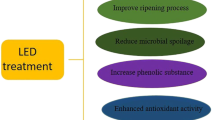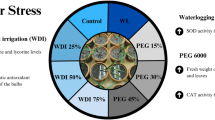Abstract
Drip loss of fresh-cut watermelon has become a concern for both producers and consumers. The effect of visible light exposure on the drip loss of fresh-cut watermelon was evaluated. Visible light treatments of 3000 and 10 Lux were applied to fresh-cut watermelon at 4 °C during the shelf life for 5 days, with light exposure of 150 Lux as the control. The drip loss of the fresh-cut watermelon at 3000 Lux was 74.8% of that at 150 Lux on the fifth day, and the moisture evaporation at 3000 Lux was 1.89 times that at 150 Lux. Moreover, the light exposure of 3000 Lux reduced the activity of polygalacturonase, which is a key hydrolase related to cell wall degradation. The cell wall degradation ratio of the fresh-cut watermelon at 3000 Lux was 81.7% of that at 150 Lux on the fifth day. Overall, light exposure of 3000 Lux reduced drip loss by accelerating moisture evaporation in fresh-cut watermelon, as well as by reducing the activity of polygalacturonase and the ratio of cell wall degradation. Hence, exposing the fresh-cut watermelon to visible light of 3000 Lux during the shelf life was a feasible way of reducing drip loss.




Similar content being viewed by others
References
Artés-Hernández F, Robles PA, Gómez PA (2010) Low UV-C illumination for keeping overall quality of fresh-cut watermelon. Postharvest Biol Technol 55:114–120
Bai JH, Saftner RA, Watada AE, Lee YS (2001) Modified atmosphere maintains quality of fresh-cut cantaloupe (Cucumis melo L.). J Food Sci-Chicago 66:1207–1211
Brummell DA, Dal Cin V, Crisosto CH, Labavitch JM (2004) Cell wall metabolism during maturation, ripening and senescence of peach fruit. J Exp Bot 55:2029–2039
Cai W, Li W, Li Y, Ma Y, Zhao X, Zhang C (2015) Screening for fresh-cut watermelon from selected cultivars. In: International conference on computer science and environmental engineering, beijing, pp 155–160
Cakmak I, Marschner H (1992) Magnesium deficiency and high light intensity enhance activities of superoxide dismutase, ascorbate peroxidase, and glutathione reductase in bean leaves. Plant Physiol 98:1222–1227
Fernández A, Picouet P, Lloret E (2010) Cellulose-silver nanoparticle hybrid materials to control spoilage-related microflora in absorbent pads located in trays of fresh-cut melon. Int J Food Microbiol 142:222–228
Fonseca JM, Rushing JW (2006) Effect of ultraviolet-C light on quality and microbial population of fresh-cut watermelon. Postharvest Biol Technol 40:256–261
Gil MI, Conesa MA, Artes F (2002) Quality changes in fresh cut tomato as affected by modified atmosphere packaging. Postharvest Biol Technol 25:199–207
Jia YJ, Feng BZ, Sun WX, Zhang XG (2009) Polygalacturonase, pectate lyase and pectin methylesterase activity in pathogenic strains of phytophthora capsici incubated under different conditions. J Phytopathol 157:585–591
Jiang Y, Shina T, Nakamura N, Nakahara A (2001) Electrical conductivity evaluation of postharvest strawberry damage. J Food Sci 66:1392–1395
Karakurt Y, Huber DJ (2002) Cell wall-degrading enzymes and pectin solubility and depolymerization in immature and ripe watermelon (Citrullus lanatus) fruit in response to exogenous ethylene. Physiol Plantarum 116:398–405
Manzocco L, Dri A, Quarta B (2009a) Inactivation of pectic lyases by light exposure in model systems and fresh-cut apple. Innov Food Sci Emerg Technol 10:500–505
Manzocco L, Quarta B, Dri A (2009b) Polyphenoloxidase inactivation by light exposure in model systems and apple derivatives. Innov Food Sci Emerg Technol 10:506–511
Mao L, Karakurt Y, Huber DJ (2004) Incidence of water-soaking and phospholipid catabolism in ripe watermelon (Citrullus lanatus) fruit: induction by ethylene and prophylactic effects of 1-methylcyclopropene. Postharvest Biol Technol 33:1–9
Mao L, Jeong J, Que F, Huber DJ (2006) Physiological properties of fresh-cut watermelon (Citrullus lanatus) in response to 1-methylcyclopropene and post-processing calcium application. J Sci Food Agric 86:46–53
Marín-Rodríguez MC, Orchard J, Seymour GB (2002) Pectate lyases, cell wall degradation and fruit softening. J Exp Bot 53:2115–2119
Martínez-Sánchez A, Tudela JA, Luna C, Allende A, Gil MI (2011) Low oxygen levels and light exposure affect quality of fresh-cut Romaine lettuce. Postharvest Biol Technol 59:34–42
McGlynn WG, Bellmer DD, Reilly SS (2003) Effect of precut sanitizing dip and water cutting on quality and shelf-life of fresh-cut watermelon. J Food Quality 26:489–498
Nilsson T (2005) Effects of ethylene and 1-MCP on ripening and senescence of European seedless cucumbers. Postharvest Biol Technol 36:113–125
Olarte C, Sanz S, Echávarri JF, Ayala F (2009) Effect of plastic permeability and exposure to light during storage on the quality of minimally processed broccoli and cauliflower. LWT 42:402–411
Petrou P, Soteriou G, Schouten RE, Kyriacou MC (2013) Effects of rind removal on physicochemical quality characteristics of fresh-cut watermelon [Citrullus lanatus (Thunb) Matsum & Nakai] during cold storage. Int J Food Sci Technol 48:357–362
Robert S, Luo Y, McEvoy JL (2007) Quality characteristics of fresh-cut watermelon slices from non-treated and 1-methylcyclopropene-and/or ethylene-treated whole fruit. Postharvest Biol Technol 44:71–79
Sanz S, Olarte C, Echávarri JF, Ayala F (2007) Influence of exposure to light on the sensorial quality of minimally processed cauliflower. J Food Sci 72:S12–S18
Sanz S, Olarte C, Ayala F, Echávarri JF (2009) Evolution of quality characteristics of minimally processed asparagus during storage in different lighting conditions. J Food Sci 74:S296–S302
Tran MTT, Farid M (2004) Ultraviolet treatment of orange juice. Innov Food Sci Emerg Technol 5:495–502
Vilas-Boas EVDB, Kader AA (2007) Effect of 1-methylcyclopropene (1-MCP) on softening of fresh-cut kiwifruit, mango and persimmon slices. Postharvest Biol Technol 43:238–244
Zhan L, Hu J, Li Y, Pang L (2012a) Combination of light exposure and low temperature in preserving quality and extending shelf-life of fresh-cut broccoli (Brassica oleracea L.). Postharvest Biol Technol 72:76–81
Zhan L, Li Y, Hu J, Pang L, Fan H (2012b) Browning inhibition and quality preservation of fresh-cut romaine lettuce exposed to high intensity light. Innov Food Sci Emerg Technol 14:70–76
Zhou B, McEvoy JL, Luo Y, Saftner RA, Feng H, Beltran T (2006) 1-Methylcyclopropene counteracts ethylene-induced microbial growth on fresh-cut watermelon. J Food Sci 71:M180–M184
Acknowledgements
The authors are grateful to financial support of the earmarked fund for China Agricultural Research System (CARS-25), Natural Science Foundation of Beijing Municipality (6172013), National Key Research and Development Program of China (2016YFD0400302-5), and Beijing Key Laboratory of Fruits and Vegetable Storage and Processing (Z141105004414037).
Author information
Authors and Affiliations
Corresponding author
Rights and permissions
About this article
Cite this article
Wang, Y., Li, W., Cai, W. et al. Visible light exposure reduces the drip loss of fresh-cut watermelon. J Food Sci Technol 55, 1816–1822 (2018). https://doi.org/10.1007/s13197-018-3096-z
Revised:
Accepted:
Published:
Issue Date:
DOI: https://doi.org/10.1007/s13197-018-3096-z




